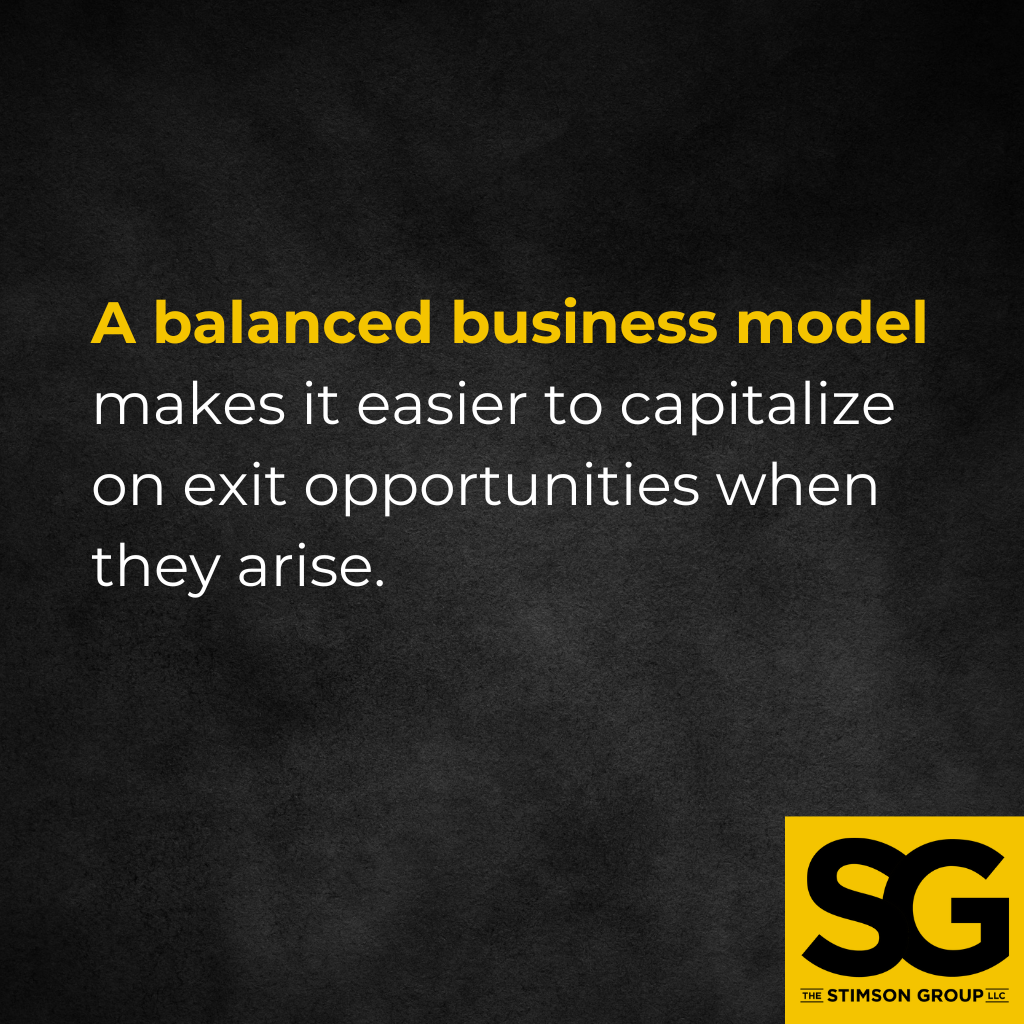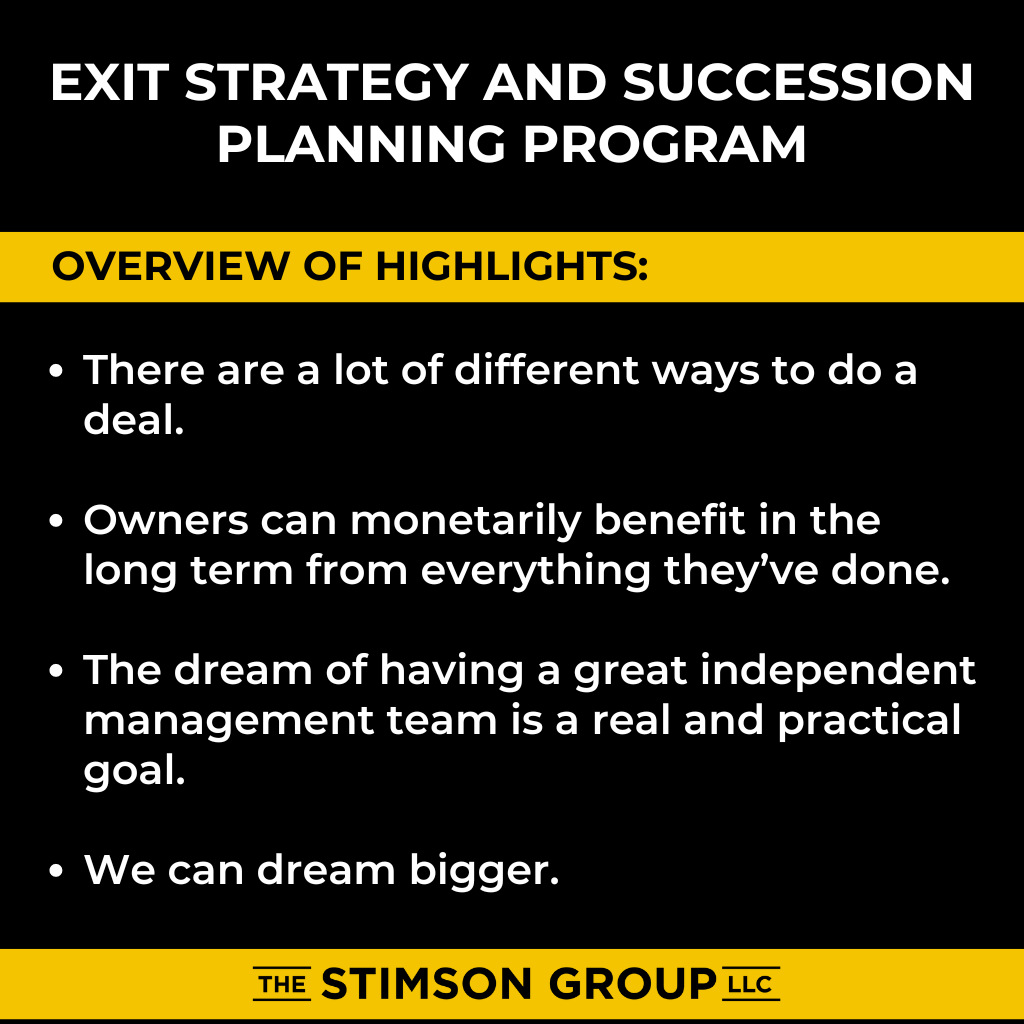
Listen instead on your Monday Morning Drive:
I hosted the Mastermind Workshop on Exit Strategy and Succession Planning in mid-2022, and it’s been on my mind the past few months.
Recently, I’ve consulted quite a few business owners who are weighing exit strategies. I’m amazed by how well the balance model pays off for owners with a clear understanding or goal for their exit strategy.
Let me share three recent examples that drove this home:
1. Succession Planning Success
I’ve been working with a company whose owner intends to sell the business to two of his employees.
By optimizing the company’s selling, planning, and administration spheres, while gradually removing the owner from day-to-day operations, we’re creating a robust, balanced business that can afford to pay him back for his equity. This approach essentially crafts a “retire-in-place” model that smoothly transitions into an ownership transfer.
Without this balanced model, the company would’ve needed to hire a slew of new employees to fill the owner’s shoes. Instead, we’re repurposing existing skills within the company to better fit the core business functions, reducing overlap and boosting efficiency.
The result? A more scalable company that easily outsources when needed.
2. Merger for Scalability
I’m also working with two companies aiming to scale up their operations. Through our discussions, they’ve realized that the fastest route to their desired scalability level is merging their businesses.
One company excels in selling, while the other shines in planning. They leverage each other’s strengths by joining forces while reducing administrative redundancies.
The balanced business model helped them recognize where they needed to channel more energy, and now they’re poised to double their business size while reducing overhead and accelerating growth.
3. Streamlining for a Quick Exit
Lastly, I’m seeing a trend among owners ready to sell and exit their businesses entirely.
By reducing the company’s dependence on the owner’s individual contributions, we’re making these businesses more attractive to venture capital firms or potential acquirers. The result? Earn-out periods typically stretching three to five years are now shrinking to one to two years or even less.
This increased scalability opens up more business-selling options and allows owners to exit more quickly with reduced financial risk during the earn-out period.
While each of these three scenarios is unique, a common thread runs through them all: a balanced business model makes it easier to capitalize on exit opportunities when they arise.
Now, let’s revisit my blog post about the Mastermind Workshop on Exit Strategy and Succession Planning. I’ll explore what we’ve learned about exit strategy options and how your balanced business model can help you achieve your long-term succession or exit goals.

What I Learned From the Exit Strategy Workshop
If I had to describe the feeling I took away from the 2022 Mastermind Workshop on Exit Strategy and Succession Planning in one word, it would be ENERGIZED.
I was thrilled because I hadn’t seen some of these people in over three years. Several have been clients for the past two years, and this was our first meeting in person.
But getting together wasn’t the only reason for the tremendous energy.
Mainly, people were energized by possibilities.
In one of the main takeaways from the event, we debunked the old, tired belief that the only way to monetize your business is to sell it when you retire. You’re NOT stuck in the paradigm of starting your business, reinvesting your blood, sweat, and tears, and then rolling the dice and hoping you sell it at the right time.
There are more reasons to have an exit strategy than selling your business when you’re too old to run it anymore. And there are much better ways to use your business in your estate planning, retirement planning, and lifestyle planning.
Owners and managers of all ages and stages got pretty excited about the things they could do in the next two, ten, or twenty years when they realized they had more choices about how they could manage their business strategies as well as their personal lives.
There was something for everybody — young, old, seasoned owners, and those just starting out.

Overview of Highlights
We learned there are a lot of different ways to do a deal.
We’re not limited to the old cut-and-dried mentality: “I put my business up for sale, hired a broker, and he found me some buyers. They made an offer. We did due diligence, and the deal closed.”
In fact, we learned that rarely ever happens.
We learned how owners can monetarily benefit in the long term from everything they’ve done.
There’s more to a business than just giving yourself a regular paycheck and hoping for an exit payday.
We talked about when brokers are appropriate and when they’re not. We looked at when selling the business is a good idea and when it isn’t. And we discussed how your business can actually provide for you long after you retire.
We even learned you can retire early if you know how to run your operation.
We learned that the dream of having a great independent management team is a real and practical goal.
Many owners left the workshop realizing that their dream of having an independent management team that could run the business to the owner’s taste isn’t some unrealistic fantasy. It’s a goal worth achieving.
It’s okay to take risks and the necessary steps to achieve that goal because it gives you more options in your long-term strategy.
We learned we can dream bigger.
A lot of owners are tired of working for their business and want their business to start working for them. But the business has been telling them they’re dreaming too big.
At the event, many owners came to the wonderful realization that they’re actually not dreaming big enough.
Embracing a bigger dream gives owners the energy to go back and say, “I’m going to work through my business to get it into position to deliver on bigger dreams.”
This is the roadmap for changing the relationship between you and your business.
Lessons I Learned
The big takeaway for me personally was the validation that the business model I’ve been promoting throughout the pandemic DOES work and helps owners reach more of their goals.
It works for the customers, the employees, and the overall health of the business. Together, all of that makes for a happier owner.
Before the pandemic, a lot of owners didn’t understand why they weren’t making more money because they thought they were doing everything right. Now, even when these owners make mistakes, they’re making money. They’re getting better and better and seeing success like they’ve never had in their careers.
The satisfaction of being in a room full of owners who are making money and who understand WHY they’re making money — lower overhead, more outsourcing, and dynamic pricing — was immense.
I don’t know how many times I heard, “I’m never going back to the old way.”
For Those Who Missed Out
If you’re wondering why you didn’t hear about the workshop until now, it’s because the event is by invitation only. I don’t set up a billboard or post come-one-come-all ads. My clients hear about it from me, and we spend concentrated time together focusing on topics that affect us all with the security of knowing that what happens in the room stays in the room.
If you want to get in on this energy, just reach out. That way I’ll know where to send the invitation next time.





Leave a Reply